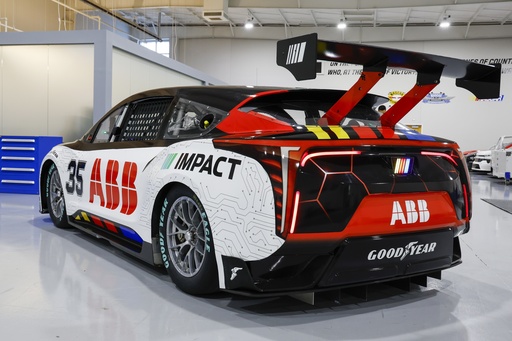One significant aspect of attending a NASCAR race is the intense sound of the engines, the approaching rumble of each car, and their swift passing at speeds exceeding 150 mph.
NASCAR introduced its initial electric racecar on a Saturday in Chicago; however, it doesn’t create a thunderous noise when the grand marshal commands, “drivers, start your engines.” Instead, it emits a hum.
The premier motorsports series in North America collaborated with Chevrolet, Ford, Toyota, and electrification company ABB to showcase a high-performance electric vehicle and assess fan interest in electric racing, aiming to portray electric vehicles and electrification in racing as trendy, entertaining, and approachable, as stated by Riley Nelson, NASCAR’s head of sustainability.
An exclusive view of the $1.5 million prototype was granted to The Associated Press. The sole individual who has driven it thus far is semi-retired NASCAR driver David Ragan. Ragan noted that the sound and smell were unparalleled compared to his experience since his debut on the racetrack at 11 years old.
The innovative car is categorized as a crossover utility vehicle, in contrast to traditional sports coupes. Sporting a substantial wing at the back, it boasts enough aerodynamics to function as a racecar.
It accelerates nearly twice as rapidly as top gas-powered racecars and can almost instantly come to a halt. Despite this, its lap time at Martinsville Speedway in Virginia was slightly slower, attributed to taking corners at a slower pace due to the added weight.
Eric Warren, overseeing global motorsports competition at General Motors, expressed that market research indicated over half of devoted NASCAR fans surveyed would exhibit heightened interest in purchasing an electric vehicle if they were introduced to it through racing.
By showcasing eco-friendly racing fuel, recycling at all events, and utilizing 100% renewable electricity at owned facilities and tracks, NASCAR aims to achieve “net zero” operating emissions by 2035.
The innovative car reflects a broader sustainability initiative by NASCAR, with ABB now serving as its official electrification partner to aid in incorporating more electricity from renewable sources. Beyond racing spectators, ABB intends to install its electric-vehicle charging stations at NASCAR-owned tracks, accessible to all electric car owners.
As part of its sustainability efforts, NASCAR has adopted the use of plant-based materials in auto bodies, like a flax-based composite from Swiss company Bcomp, instead of traditional carbon fiber composites.
Additionally, NASCAR is exploring hydrogen-powered cars and adapting hybrid engines in association with IMSA. Ford Performance has also developed eight state-of-the-art electric demo vehicles in four years to align with the evolving market trends.
The rise in U.S. electric vehicle sales by 7% in the first half of the year suggests a growing segment of consumers looking towards electric cars. ABB Executive Vice President Michael Plaster hopes that the new electric car showcased at NASCAR events will spark curiosity among children and inspire them to consider a future reliant on clean energy solutions.
This website uses cookies so that we can provide you with the best user experience possible. Cookie information is stored in your browser and performs functions such as recognising you when you return to our website and helping our team to understand which sections of the website you find most interesting and useful.
